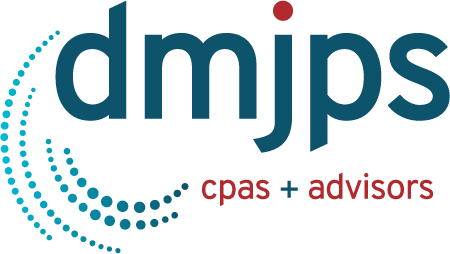Highlights:
DMJPS is pleased to provide our first quarterly statewide economic report for North Carolina. In the first quarter of 2022, the state of North Carolina experienced positive gains across the majority of economic indicators. Leading metros included Raleigh and Durham-Chapel Hill, as well as Charlotte, Wilmington, Asheville, and Greenville.
With a population of 10,551,162 per the U.S. Census Bureau, North Carolina was the ninth most populous state in the U.S. in 2021. The state ranked fourth in most numeric population added in 2020-2021 (+93,985) following only Texas, Florida, and Arizona. While gaining population through net international migration (+6,756), the growth in North Carolina was primarily driven by net domestic migration (+88,673). Natural increase experienced a decline (-1,698) and population change that could not be attributed to any specific demographic component, or residual, was estimated at 254.
- In the first quarter of 2022, the state of North Carolina gained an average 4.0 percent employment, or 178,900 jobs compared to a year earlier.
- Averaging 3.7 percent over the first quarter of 2022, North Carolina’s unemployment rate remained below the national average of 4.1 percent. At 2.9 percent, Durham-Chapel Hill had the lowest average unemployment rate among the state’s fifteen metros.
- All major industries except for Mining and Logging added employment in the first quarter of 2022 when compared to a year earlier. Leisure and Hospitality led with approximately 50,400 new net jobs.
- North Carolina’s average hourly wage rose to $29.58 in the first quarter of 2022, an increase of 8.8 percent year-over-year and the largest quarterly year-over-year increase going back to 2020. The Charlotte and Raleigh Metros led the state’s fifteen metros with average hourly wages of $32.83 and $32.63, respectively.
- North Carolina’s first quarter 2022 same-home annual appreciation rate was up 23.7 percent from a year earlier. The state’s appreciation rate was greater than the national average of 19.4 percent. The Raleigh Metro had the greatest rate of change at 28.3 percent, followed by the Charlotte Metro at 25.1 percent.
- Taxable retail sales in the state of North Carolina totaled approximately $49.3 billion in the first quarter of 2022, a 9.0 percent increase compared to a year earlier.
Detailed Analysis:
Employment
In the first quarter of 2022, employment in the state of North Carolina increased by an overall average of 4.0 percent (Figure 1 and Figure 2). This growth rate represented an average increase of approximately 178,900 jobs as recovery from the effects of the COVID-19 pandemic continued. The nation’s average growth rate of 4.7 percent in the first quarter was slightly higher than the state (Figure 2).
Figure 1
Total Employment
Monthly Year-to-Year
Percent Change
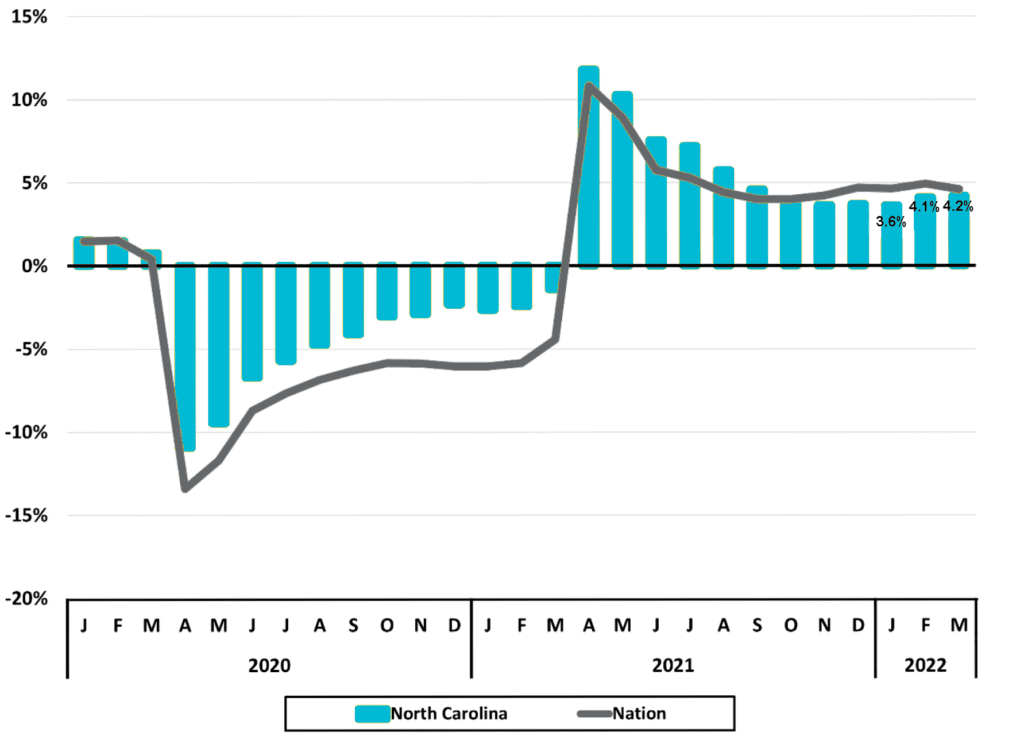 Source: US Bureau of Labor Statistics
Source: US Bureau of Labor Statistics
Each metro in the state of North Carolina gained employment in the first quarter compared to a year earlier, as did the nation. The state’s top three metros for percentage rate of employment gain over the first quarter were the Raleigh, Wilmington, and Asheville metros (Figure 2). These three metros outpaced the state’s overall growth rate of 4.0 percent. Additionally, both the Raleigh and Wilmington metros outpaced the nation’s overall 4.7 percent.
Figure 2
2022 1Q Average
North Carolina Metros
Employment One-Year Percent Change
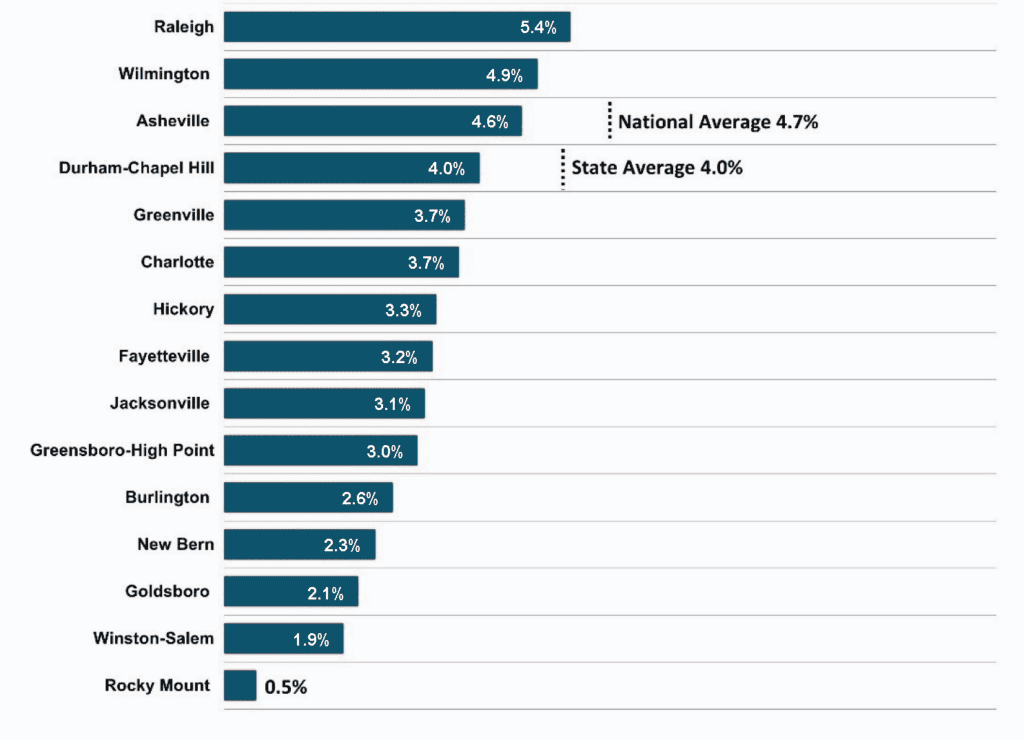 Source: US Bureau of Labor Statistics
Source: US Bureau of Labor Statistics
Averaging 3.7 percent over the first quarter of 2022, North Carolina’s unemployment rate was lower compared to the national average of 4.1 percent (Figure 3 and Figure 4). The state’s unemployment rate dropped each month in the first quarter of the year. The unemployment rate in the state translated into roughly 185,713 people who were unemployed, a decline of 32.8 percent compared to a year earlier. The state metros with the lowest unemployment rate during the first quarter were Durham-Chapel Hill (2.9 percent), Asheville (3.0 percent), Raleigh (3.0 percent), and Wilmington (3.2 percent).
Figure 3
Unemployment Rate (%)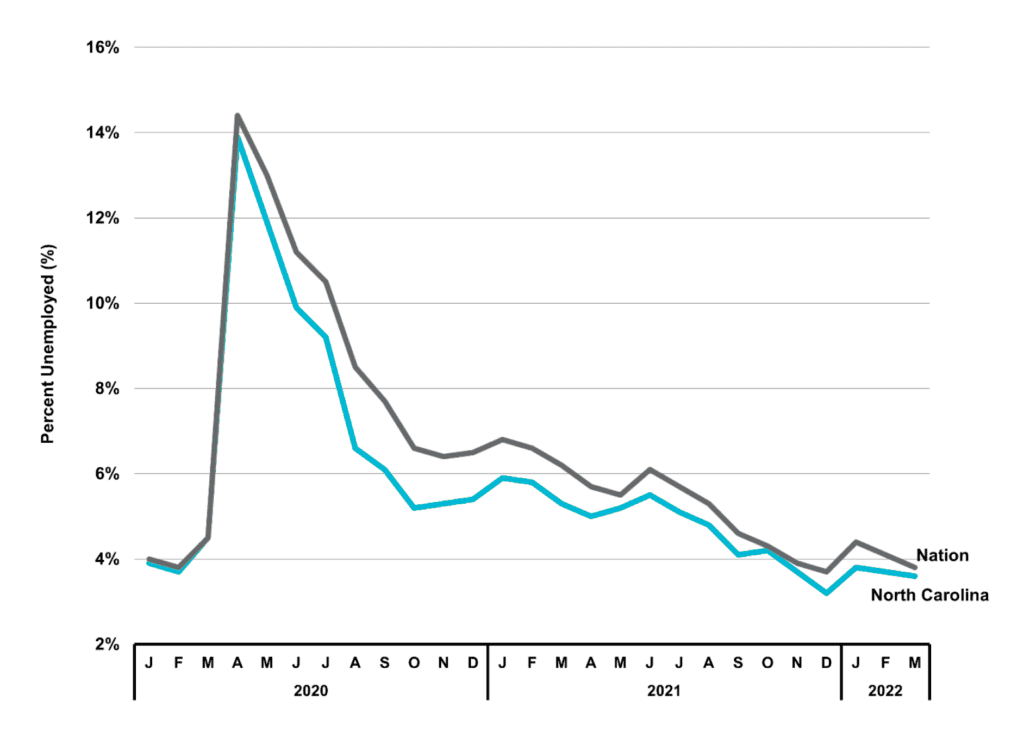
Source: NC Department of Commerce
Figure 4
Unemployment Rate (%)
2022 1Q Average
 Source: NC Department of Commerce
Source: NC Department of Commerce
In the first quarter of 2022, all major industries increased employment compared to one year earlier except for Mining and Logging. Leisure and Hospitality’s net increase of 50,400 jobs and Professional and Business Services’ net increase of 42,700 jobs led overall employment gains and made up over half of the state’s total nonfarm employment growth (Figure 5).
Figure 5
North Carolina – 2022 1Q
Major Industry Employment
One-Year Change
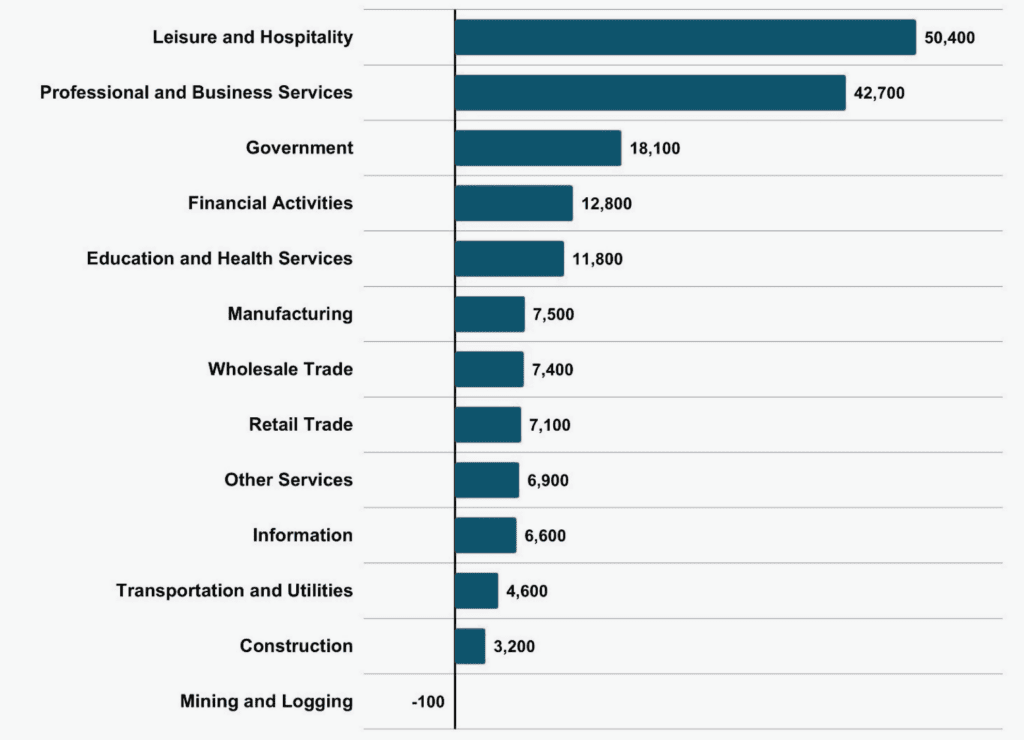 Totals rounded to nearest 100
Totals rounded to nearest 100
Source: US Bureau of Labor Statistics
Wages
Private industry average hourly wages in the state of North Carolina averaged $29.58 in the first quarter 2022, an 8.8 percent increase from a year earlier (Figure 6). This marked the third consecutive quarter with positive year-over-year gains. State metros with the highest average hourly wage were Charlotte ($32.83), Raleigh ($32.63), and Durham-Chapel Hill ($31.11). These three metros exceeded the overall state’s average while the Charlotte and Raleigh metros also exceeded the national average of $31.78 (Figure 7).
Figure 6
North Carolina
Average Hourly Wages
Private Industry
 Source: NC Department of Commerce
Source: NC Department of Commerce
Figure 7
North Carolina Metros – 2022 1Q
Average Hourly Wages
Private Industry
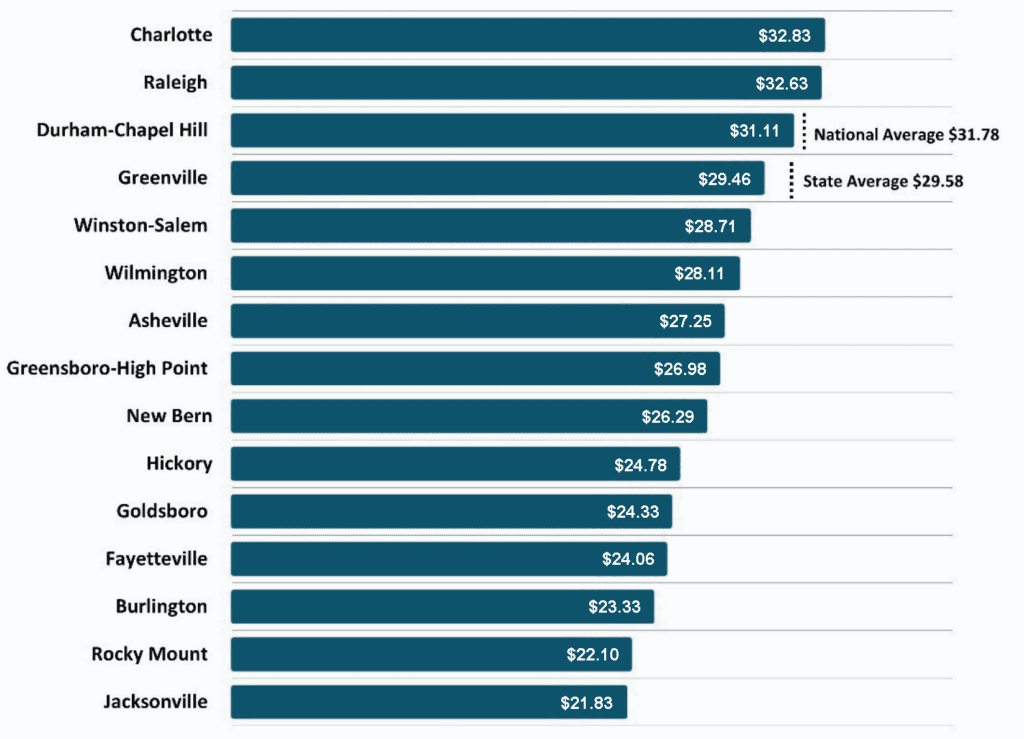 Source: NC Department of Commerce
Source: NC Department of Commerce
Housing
At 23.7 percent, the state of North Carolina’s Same-Home Annual Appreciation Rate surpassed the national rate of 19.4 percent in the first quarter of 2022 (Figure 8). North Carolina metros with appreciation rates that exceeded the state’s first quarter average included Raleigh (28.3 percent), Charlotte (25.1 percent), Durham-Chapel Hill (24.1 percent), and Wilmington (23.8 percent). Except for the Greenville Metro, all state metros exceeded the national average.
Figure 8
North Carolina Metros
Same-Home Annual Appreciation Rate (%)
2022 1Q
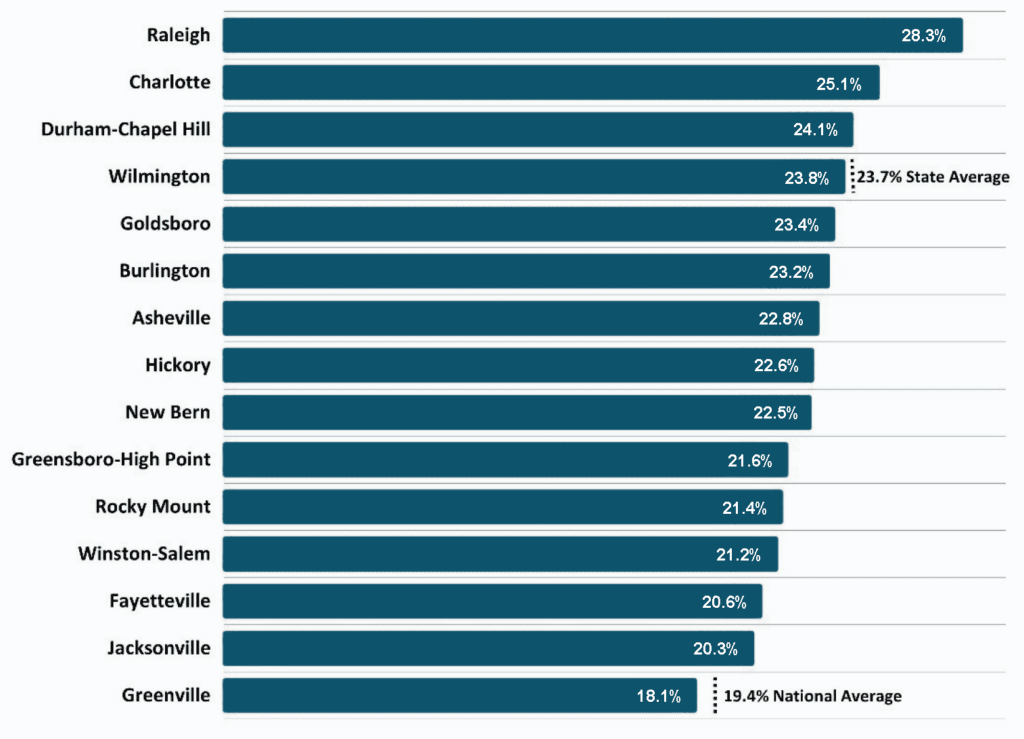 Source: Federal Reserve Bank of St. Louis
Source: Federal Reserve Bank of St. Louis
Estimated permit activity for new residential building in the state of North Carolina totaled 24,499 units in the first quarter of 2022 for single family and multi-family units combined (Figure 9). The total value of $5,461,284,000 ($5.5 billion) exceeded each quarter going back to 2020. In the first quarter, the total number of units permitted was up 8.8 percent and the total value was up 7.9 percent from one-year earlier. Permitted multi-family units totaled 5,804, accounting for 23.7 percent of building permits.
Figure 9
North Carolina
Estimated Residential Building Permits Activity*
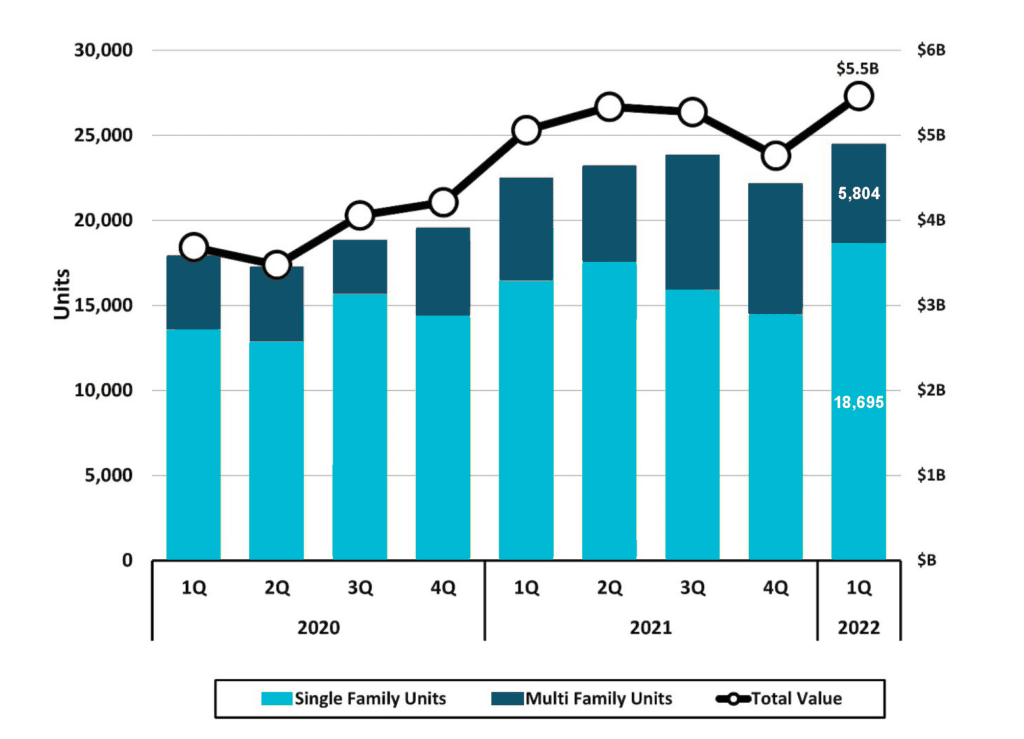 *Based on a survey of permitting agencies. The Census Bureau provides estimates for
*Based on a survey of permitting agencies. The Census Bureau provides estimates for
any missing agency data, which typically amounts to less than 20% of the total permits.
Source: US Census Bureau
Retail Sales
Taxable retail sales in the state of North Carolina totaled $49,317,088,518 ($49.3 billion) in the first quarter of 2022. This was down slightly from the previous three quarters but represented a 9.0 percent increase compared to a year earlier (Figure 10 and Figure 11).
Figure 10
North Carolina
Total Taxable Retail Sales
 Includes collections of penalties, interest, and sales & use tax; and may reflect activity from prior periods.
Includes collections of penalties, interest, and sales & use tax; and may reflect activity from prior periods.
Source: NC Department of Revenue
Figure 11
North Carolina
Total Taxable Retail Sales
Quarterly Year-to-Year Change (%)
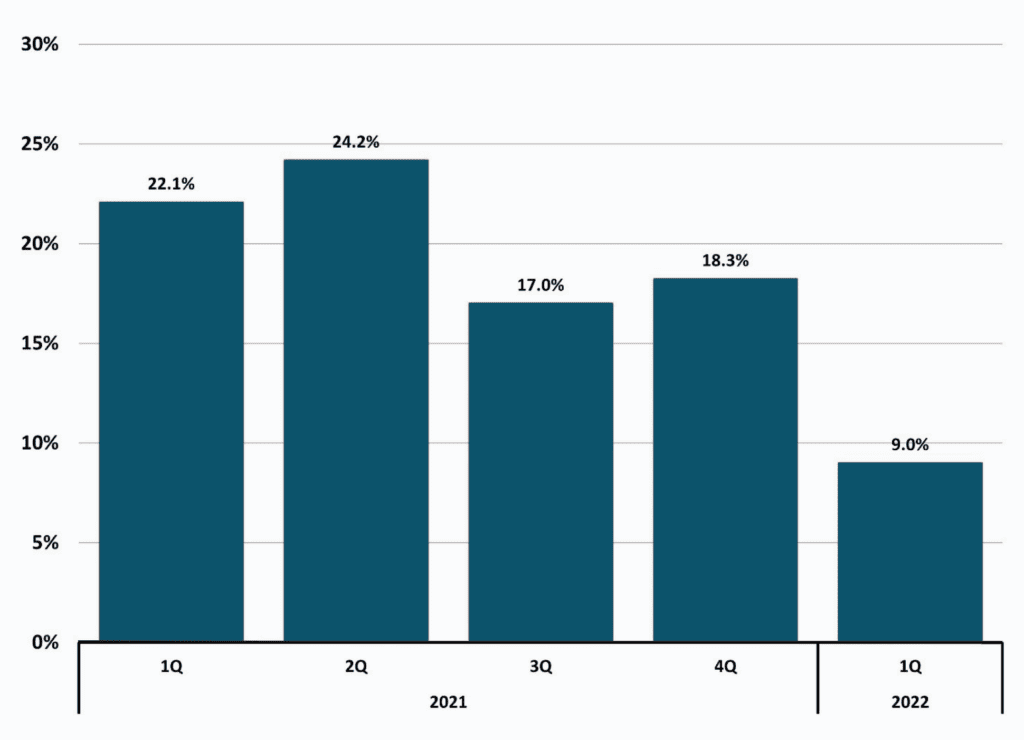 Includes collections of penalties, interest, and sales & use tax; and may reflect activity from prior periods.
Includes collections of penalties, interest, and sales & use tax; and may reflect activity from prior periods.
Source: NC Department of Revenue
For a printer-friendly version, CLICK HERE.
End note: Data reflects a snapshot or point in time, July 2022, and may be subject to periodic adjustment.
Need help navigating your business? Contact DMJPS.
